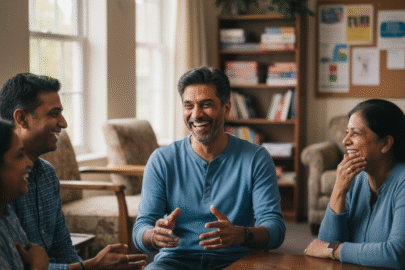
A Gentle Guide to Staying Sharp, Calm, and Connected
Introduction: Why Brain Health Becomes a Priority After 50
As we grow older, we gain wisdom, experience, and perspective. But many also begin to notice subtle changes, forgetting a word, losing track of time, or feeling more mentally tired than before.
These changes can be unsettling. You might wonder, “Is my mind slowing down?” or “What can I do to stay sharp?”
The good news is: your brain, even after 50, has the ability to grow, adapt, and heal. And one of the most powerful, yet gentle, ways to support brain health is through mindfulness and meditation.
These practices aren’t just for yogis or spiritual seekers. They’re everyday tools anyone can use to calm the mind, sharpen memory, improve mood, and feel more in control of their thoughts.
Let’s explore how they work and how you can start.
What Are Mindfulness and Meditation?
Mindfulness and meditation are simple, practical habits that help you stay present.
- Mindfulness is paying attention to the current moment, your breath, your surroundings, or your thoughts, with curiosity instead of judgment.
- Meditation is a focused period when you gently guide your attention inward, often using the breath or a calming image.
Many people think meditation means sitting cross-legged in silence for hours. But that’s not necessary. You can do it while walking, sipping tea, or even lying in bed.
These practices are not about “stopping your thoughts”; they’re about not getting carried away by them. That one shift makes a big difference in how you feel and how your brain functions.
Why Your Brain Loves Mindfulness and Meditation
Here’s what science (and experience) tells us: when you practice mindfulness and meditation regularly, your brain changes, for the better.
1. Sharper Thinking and Better Memory
Mindfulness improves attention and concentration. You’re more likely to remember names, follow conversations, and solve problems.
2. Less Stress and Anxiety
Meditation lowers the stress hormone cortisol. This helps reduce worry, calm your heartbeat, and improve emotional stability, especially helpful during transitions like retirement.
3. Protection Against Cognitive Decline
Research shows regular meditation can slow age-related memory loss and improve brain plasticity, your brain’s ability to grow new connections.
4. Deeper, More Restful Sleep
Practicing mindfulness at night helps quiet the mind, making it easier to fall asleep and stay asleep. That, in turn, improves mood and memory.
Why Awareness Matters: You Can’t Change What You Don’t Notice
Many stressful moments begin with autopilot thinking, old habits, or emotional reactions that happen without us realizing it.
For example:
- You forget a task → Think “I’m getting old” → Feel discouraged → Stop trying
- You feel lonely → Think “No one cares” → Feel sad → Withdraw even more
Mindfulness teaches you to pause between thought and emotion. That pause gives you power, the power to choose a different thought, a different feeling, and a different response.
This gentle awareness strengthens your brain’s emotional and logical centers.
Simple Mindfulness Practices to Get Started
You don’t need hours or expensive tools. Just a few minutes a day can begin to create change. Start with one of these:
1. Breathing Awareness (3–5 minutes)
- Sit comfortably.
- Inhale slowly for 4 counts, exhale gently for 6.
- Focus only on your breath, nothing else.
- If your mind wanders, gently return to the breath.
This resets your nervous system and boosts oxygen to the brain.
2. Mindful Sensing
Use your senses to anchor yourself in the moment:
- Listen to nearby sounds.
- Feel the warmth of sunlight or the coolness of air.
- Taste your tea slowly, noticing each sip.
Doing this for 1–2 minutes a few times a day increases presence and reduces mental clutter.
3. Mindful Walking
- Take a short walk (even indoors).
- Feel each step, each shift of weight.
- Breathe slowly, matching steps to breath.
- Notice the world without rushing through it.
4. Gratitude Reflection
At the end of the day, ask:
- What went well today?
- What did I handle calmly?
- What am I grateful for?
Writing this in a journal strengthens positive thought patterns and brain connections related to joy and confidence.
Gentle Meditation Tools to Try
You don’t need to meditate “perfectly.” You just need to begin.
1. Anchor-Based Relaxation
- Choose a gentle physical cue like touching your thumb and forefinger together.
- Each time you do this while breathing calmly, your body learns to associate it with relaxation.
- Over time, just using this anchor brings calm automatically.
2. Calm Place Visualization
- Close your eyes and imagine a peaceful place (a garden, beach, mountain).
- Feel the sights, sounds, and comfort of that place.
- Stay there for 5–10 breaths.
This visualization soothes the mind and activates healing pathways in the brain.
3. If/Then Mental Reset
Use this to create new habits of emotional balance.
- If I feel overwhelmed or distracted,
Then I will take 3 deep breaths and remind myself: “I return to this moment.”
Repeat this often, and it becomes a calming mental habit.
Creating a Routine That Works for You
You don’t need to follow a strict schedule. Think of mindfulness like vitamins; a little each day makes a big difference.
Sample Gentle Routine:
- Morning: 3 minutes of deep breathing
- Midday: 1-minute sensory break or mindful walk
- Evening: Gratitude journaling or calm place visualization
You can use reminders, like mealtime, walking, or brushing teeth, to anchor your practice into daily life.
Final Thoughts: A Stronger, Calmer Brain Starts with a Single Breath
No matter your age or past habits, your brain can grow, heal, and improve. It responds to kindness, awareness, and consistent care.
Mindfulness and meditation are not about becoming someone else. They’re about returning to yourself, more grounded, present, and in control.
You don’t need more time. You just need this moment.Start with one breath. One pause. One reflection.
And you’ll be surprised how much clarity and peace begin to unfold.
*Images have been generated using AI tools





